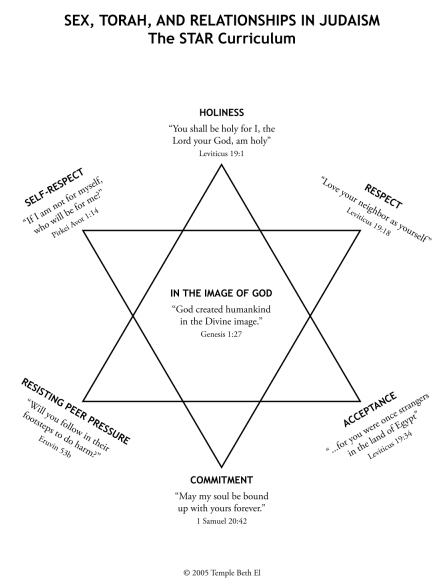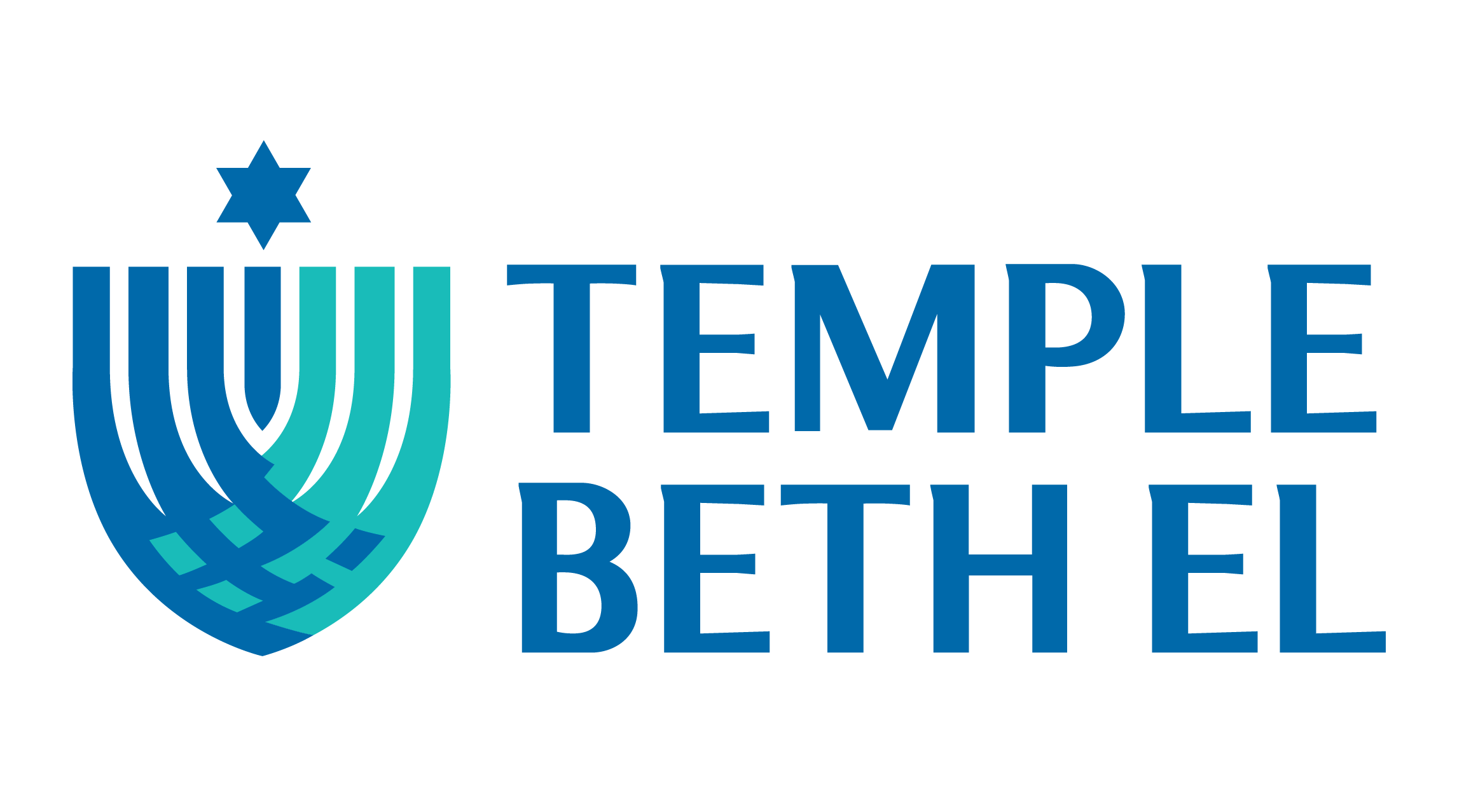The month of January sees the launch of this year’s 6th, 8th, and 9th grade human sexuality program at Temple Beth El. This is the central part of our STAR (Sex, Torah, and Relationships) Curriculum that begins with parents of preschoolers and concludes with a pre-college program for our Post-Confirmation (11th and 12th grade) students. The acronym refers to the Star of David diagram that lays out the fundamental guidelines of relationships of all types infused with Jewis h values.
h values.
The 6th grade program is designed for students about to enter the increased social challenges of the b’nei mitzvah year, and the 8th and 9th grade program for teens gives them knowledge and tools for taking on some of the biggest challenges of identity and socialization of their young lives. These two programs are the heart of the curriculum. The primary focus of the STAR Curriculum is on age-appropriate relationships of all types, including the values that contribute to healthy relationships, and how to recognize and remove yourself from unhealthy ones. There is also a significant amount of time devoted to teaching and review of the biological components, compiled and taught by medical professionals. While the students tell us constantly that they learn these things in school, our experience is that their knowledge is, at best, incomplete. More importantly, the STAR curriculum is a values-based program, which a secular school curriculum must necessarily avoid.
The biggest challenge for the team that oversees the program is keeping up with the ever-changing landscape of relationship formation and vocabulary. Every year we evaluate the program, identify both the strongest and weakest components of the individual lessons, and consult with those in the know (professionals who routinely deal with teens, as well as the teens themselves) in order to remain relevant and helpful.
This year, we have moved forward in two important areas. First, the team has taken on the challenge of learning about the expanding modality of gender identity and expression in our 8th and 9th grade lessons. Over the past decade, we’ve gotten pretty good at dealing with the dualities of male/female and heterosexual/homosexual relationships. This year we brought in an educator from Time Out Youth (the Charlotte organization providing support and advocacy for LGBTQ youth ages 11–20) to discuss the ways in which people self-identify outside of these binary norms. Second, we are researching and making available some parent resources for having age-appropriate discussions with your children as they grow up, ask questions, and face increasing challenges. The Temple Beth El Gift Shop will soon be stocking some outstanding books for parents of young children through the teenage years.
The number of people we encounter who self-identify outside of the traditional binary gender norms is admittedly quite small. So why focus on this? There are two extremely important reasons. First, we want to be sure that any teens wrestling with their gender identity have an accepting, safe, and loving space in which to explore and grow. While we are not experts in many of these areas, the fact that we are open to discussing a broad range of gender modalities offers a place of safety to those who struggle. Second, and perhaps more important, the majority of our teens live in a world where the discussion and the reality of broader gender definitions are commonplace. Our willingness to wade into the discussion lets them know that we are also open to the breadth of issues they may face, even if their personal challenges fall within a more “traditional” framework.
As the clergy voice on the team, it is my job to create the Jewish framework for these discussions. As you can imagine, this is an interesting challenge as the Torah is not explicit in how to view or treat those who self-identify as, for example, transgender or pansexual.
In 8th grade, we spend a good deal of time talking about the quality of relationships with others. The basis for the discussion is the work of philosopher Martin Buber who contrasted I–It relationships (in which you encounter another person without having any vested interest in them) and the more desirable I–Thou relationships (in which you have some stake in the other person). These two types of encounters run parallel to the concepts of tolerance versus acceptance. How do we achieve acceptance?
In his book on gender, author and activist Sam Killerman rails against the ubiquitous Golden Rule (common to many faiths, including Judaism), which essentially says, “Treat others as you wish to be treated.” He rightly points out that making the assumption that everyone should be content with what is comfortable to you is actually a bit arrogant and works against acceptance of different ways of being. This approach is the basis for the disgraced reparative therapies — you should “fix” others so they will be happy being just like you. Killerman goes on to propose the Platinum Rule: “Treat others as they wish to be treated.” But how can you know that? Well…you have to ask — which converts the I–It relationship to I–Thou.
This makes quite good sense. But from a Jewish perspective, this raises one very important question: if the Golden Rule is rooted in Jewish tradition, can the Platinum Rule also be Jewish?
In 9th grade, we examine more closely the validity and pitfalls of how we express our identity. And we questions whether Judaism allows for anything outside of “traditional” male/female gender identity and expression. The central tenet of our program is in the center of the STAR diagram: human beings are created in the Divine image. But the way in which an endless variety of humans results from a single but infinite God is not obvious, as revealed in the text study that follows. Wrestling with these concepts takes openness, patience, compassion, and a commitment to lovingly embrace those whose personal reality can be quite different from our own.
TEXT STUDY
Genesis 1:1 — In the beginning, God (elohim) created (bara)…
Genesis 1:27–28a — And God (elohim) created (bara) [the] man (ha-adam) in His image; in the image of God, He created him, male and female He created them. And God blessed them…
Genesis 5:1–3a — This is the book of the generations of adam (Adam/Man): in the day God (elohim) created (bara) Adam/Man, He made (asah) him in His likeness (d’mut). Male and female He created them (baram), and [God] blessed them, and He called their name adam (Adam/Man), in the day on which they were created (ha-baram). And adam (Adam/Man) lived 130 years….
There are a number of concepts in Torah that are not as clearly defined (black and white) as we assume them to be in our everyday world: singular/plural and gender being two of them. The (One) God who creates is called Elohim, a plural noun. Adam alternately refers to Adam (an individual human being), the primordial human being (who fluctuates between “him” and “them”), and Humankind.
Genesis 1:27 says, “And God created the human (the human race?) in His image; in the image of God He created him, male and female He created them.” The next verse begins, “And God blessed them….”
We say that God is infinite and beyond our understanding. God who is known by a plural name would imply God’s infinite nature. If human beings are created in the image of the Infinite One, that would explain the diversity of the human race: each of us could be uniquely represented in an infinite God. The notion that God is beyond our understanding is affirmed by the anthropomorphism used in conjunction with God in the Torah (“the hand of God,” etc.). The anthropomorphism is simply a crutch for us limited human beings in order to get our minds around the concept of “God.”
Perhaps gender is also infinite (has infinite permutations) and is beyond our understanding. Have we simplified it into male and female out of our need to get our minds around such a basic characteristic? One commentary suggests that the first human was androgynous and was then separated out into two individual human beings, one male and one female. Perhaps. But is it possible that an infinite variety of gender-associated permutations were contained within the first human being?
As we, in the 21st century, try to expand our thinking beyond the simple duality of male/female, are we breaking new ground? Or are we simply catching up to what the Torah was trying to say to us thousands of years ago?




